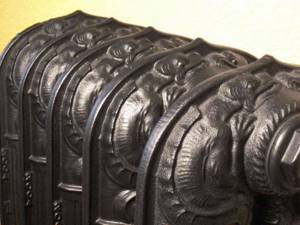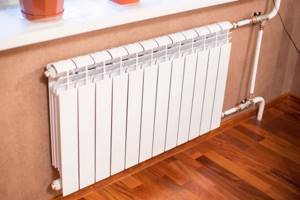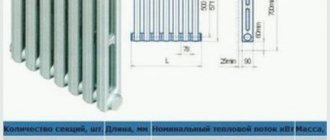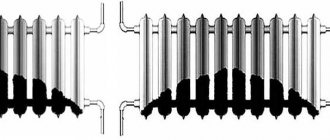We recently bought an apartment and didn’t have time to change the batteries - we turned on the heating. The house is a cooperative one, turning off the heating must be agreed upon with the house eldest. She categorically refused to do this, and the local mechanic, bypassing her, also refused to help us. They suggest waiting until the end of the heating season. What can be done in this situation? And one more thing: if you still have to wait for spring, is it possible to fill the floors, lay laminate and stretch the ceiling, and then replace the batteries? Please advise how to make sure that the repair after replacing the radiators does not suffer, otherwise I just give up.
Experts answered the question
Best answer
Here Vladimir discovered such technologies! Freezing. Live and learn. It seems to me that Alina has no urgent need to install these batteries at any cost. It’s just that a person is worried, but then how to do it?!
Alina, lay the film on the floor, put wet rags or damp cardboard on it. And let the master fiddle there with his welding/grinder. For me, this is a simple additional movement, much simpler than persistently breaking through the knots, which will disappear on their own in the spring. If the renovation is planned to be finally completed, say, by the new year, then yes, of course it’s worth following Vladimir’s advice.
water wears away stones. If the manager (chairman of the cooperative, etc.) does not fulfill his duties, if he exceeds his official powers, and in general is not satisfied with his work, then why should he sit in his chair and receive a salary? I repeat once again - there is not a single regulatory document in nature that prohibits turning off the riser during the heating period in order to replace the radiator. There are no such regulations. Neither at the federal level, nor at the municipal level, nor at any other level. This is nothing more than the arbitrariness of a particular person. Either out of stupidity or self-interest.
By the way, this situation is not new. About 6 or 7 years ago I encountered a similar problem. A small house, three floors, three entrances. Cooperative. The woman was quite young (about 35 years old), a single mother with 2 jobs and also danced in the evenings in clubs (very pretty, by the way), in general she was spinning around like she was in a frying pan. I saved up for an apartment in this house, I renovated it. No matter where you poked, they ran into NIZZY. The same risers, for example. In the end, I got tired of it all and I jokingly told this woman that with your energy, you need to become the chairman of the cooperative yourself. You won’t believe it, but after 3 months it happened. First of all, she ran around all the apartments and collected signatures for an extraordinary meeting. They demanded a balance sheet and other bullshit. There she nominated herself for this position. Then a couple of months of butting heads with the chairman, but she didn’t waste any time. I told her what and how needed to be done in this house (there was no grounding and something else needed to be done on the roof), as well as how to dispose of the territory adjacent to the house (on the balance of the cooperative) - demolish all the unauthorized garages, drive out the beer stall and make a playground, a parking space, etc... I didn’t delve into how she did the project, maybe she drew and calculated everything herself, but the point is that after 3 months she was the chairman.
Battery replacement procedure
If your old batteries have valves, then you can replace the battery without resorting to draining the water from the risers; you just need to turn off the taps, cut off the old battery (with the assistance of a mechanic or yourself) and attach a new one, then open the valves and check the tightness of the connections.
If there are no valves on old batteries, the replacement procedure consists of the following steps:
- contacting the housing office or departmental office, where the necessary documents are prepared and a receipt is issued;
- payment of the receipt at any bank branch or via the Internet.
The cost of disconnecting and draining one riser, depending on the region, can vary from 300 to 3000 rubles per hour of disconnection.
3. on the appointed day and time, several employees of the housing office/daily office carry out joint replacement work: the riser is turned off and drained, the battery is replaced and then pressure is applied to the heating system and the quality of work is checked.
In general, replacing a battery in winter is only slightly different from replacing it during the non-heating season and takes a little longer. Usually the procedure lasts 1-2 hours, so in order to avoid unpleasant situations, you must notify your neighbors in advance about your plans.
The management company refuses to change radiators - what should residents do?
The management company deals with the repair of the municipal heating system and replacement of its elements within the building .
She must monitor the condition of the risers of the apartment building, heating pipes, and carry out repair work if necessary.
Battery replacement is free of charge . the owner of the property usually pays for the replacement of radiators .
If the management company repairs the risers unconditionally, then the management company often refuses to change the equipment in the apartment for free.
ATTENTION! In this case, you should write an application for a replacement officially and register it. It is recommended that you consult with a lawyer experienced in utility law on this issue.
If the management company ignores consumers and does not deal with its direct business, a written appeal will become the basis for going to court .
Useful little things
Initially, you need to take care of the availability of special tools. If you have to replace the heating batteries yourself, then simply sketching the project will not be enough - you need to understand every nuance of the installation. At a minimum, it is worth adopting a few basic rules.
So, the battery must be installed at an angle: otherwise air will accumulate in it, which will have to be blown out so that the heat transfer efficiency of the radiator does not decrease. If we are talking about installing a cast iron radiator, then it should be disassembled and reassembled before installation.

There are a number of other points that are worth paying attention to. To get a more complete picture, you need to consult with specialists or search for information on the Internet in advance. Replacing batteries is a truly labor-intensive process that requires scrupulous technology.
When to change batteries
Heating in our country is an annual and painful issue. Even in the warmest regions it is required in winter. And when the time comes to say goodbye to old batteries, many people simply take it upon themselves. This article will discuss the most key issues - the reasons for replacement, which radiator to choose, and, most importantly, when is the best time to change them.
Why change batteries?
The main reason is system wear. Everything has a shelf life and the heating system is no exception. Or maybe the owner decided that the old cast iron does not suit the interior and it’s time to refresh the appearance.
- System wear and tear. The most common and, as often happens, sudden case. Over time, old cast iron radiators and pipes become clogged. They stop delivering the required amount of heat, but heating costs remain the same. And one day they either stop working completely, or a free pool of foul-smelling boiling water opens in the house. Then the decision comes that it was high time to change the batteries.
- Couldn't withstand the load . The difference between this problem and the one above is that heating systems are checked before each heating season. The goal is simple - to identify problems, possible leaks and weak points of the entire heating network. Increased load is applied from the pipe. And where everything is visually normal, a leak may form. Of course, the solution can be simpler - eliminate the defect in a specific place. But this does not guarantee that the same battery will not start leaking during the season. A hidden defect that appears as a result of an inspection can really ruin your mood during the winter cold. And it will significantly hit your pocket, but more on that later.
- We are doing repairs . Everything is much simpler there. Many people have long been tired of old Soviet cast-iron radiators. Despite all their positive characteristics in the past, they have already served their time. It's worth noting that this does not apply to new batteries that are still on sale. And purely aesthetically, in order for the repair to have a completely completed look, the radiator sections are replaced with more modern models. They look nicer, and their characteristics are an order of magnitude higher than their predecessors.
What to buy
Today, construction stores have a huge number of models that differ in both appearance and functionality.
- Cast iron . Long-lasting radiators that have proven their quality over decades. Relatively low price and easy to install. One “but” is weight. But, if the priority is to replace the heating battery in an apartment cheaply , then this is an ideal option.
- Bimetallic . A combination of aluminum and steel with powerful heat dissipation and corrosion protection. Lightweight, durable and expensive.
- Steel . They are practically in no way inferior to the others, but conduct heat a little worse.
You should decide based on your wallet and personal impression of the appearance. They have no fundamental difference in heat transfer.
What difficulties with the law may arise if you carry out the work yourself?
Replacing batteries in an apartment yourself is fraught with:
- disturbance of heat exchange in the house;
- emergency situations;
- fines.
If you replace the batteries without permission, then in case of any accidents, the owner of the apartment will pay for damage to property. Moreover, not only to neighbors, but also to the management company.
Batteries that do not belong to the property of the management company can be replaced only after receiving written permission.
It is better to entrust the work to the employees of your management company, since in further emergency situations they will be responsible for violations in the operation of the heating system of the house. Third-party organizations will not be able to provide the homeowner with legal protection in the event of accidents, including those that arose through no fault of the homeowner.
You may be interested in looking at other articles about heat supply rules, commercial heat energy metering, types and costs of major and other types of repairs of heating systems in an apartment building, heat metering devices, heating season schedule in 2021, reasons for turning off heat supply in an apartment and noise in batteries, temperature charts and water heating standards in heating system radiators, as well as what to do if the battery leaks.
How to choose the right radiator
There are only 2 fundamental criteria: design and heat transfer. In terms of the second indicator, cast iron batteries remain unsurpassed, although aesthetically they look unattractive. But in modern stores you can also find artistic cast iron. Such devices are heavier than conventional ones, but they also heat better, and they don’t care about water hammer (sharp pressure drop), and besides, they look beautiful.

There is a growing popularity of bimetallic radiators, which perfectly resist corrosion and fit harmoniously into almost any interior. Manufacturers offer both wall-mounted and floor-mounted options. Such devices are connected using polypropylene pipes, the service life of which is 50 years. Elegant products look beautiful and last a long time.

To make the indoor microclimate comfortable, you will need to perform a simple calculation. First, the number of connecting devices is determined. For example, the area of the room is 20 square meters. m. To heat every 2 meters, there is 1 section and 1 additional section for the entire room: 20: 2 + 1 = 11. A cast-iron device with so many elements will look cumbersome, a bimetallic one will look quite nice. But, if there are 2 windows in the room, it is better to place 2 batteries under them for 5 and 6 sections - this is the optimal solution.
Next, the amount of heat is calculated. It is different for each type of house.
The norm for heating one cubic meter of room is:
- for new buildings - 20 W;
- for brick buildings - 34 W;
- for panel buildings - 41 W.
Therefore, for the calculation it is necessary to know the heat transfer of one section. Let it be 100 W. We consider the volume of a room with an area of 20 square meters. m: 5 × 4 × 2.5 (ceiling height) = 50 m³. Let's say this is a new building. Then to heat the room you will need: 50 × 20 = 1000 W. We have 2 radiators with a total number of sections of 11. We multiply them by one hundred and get the result: 11 x 100 = 1100 W with the required 1000 W. Two batteries for 5 and 6 sections are quite enough to maintain a comfortable microclimate. Provided that there are no heat leaks through doors and windows.

Prices for heating radiators from different manufacturers
heating radiators
Types of radiators and their choice
Before choosing heating batteries at a retail outlet, it is advisable to know the composition of the coolant.
Heating battery connection diagram.
If the house is private, then everything is clear, but apartment owners will have to obtain the necessary information from the management organization. The quality of the coolant can be indirectly judged by the material used to make the radiators. For example, cast iron radiators indicate that the quality of the coolant is most likely not up to par. In this case, you should be careful when choosing a heating battery and take into account that aluminum and steel products are quite capricious to “extra” impurities in the coolant.
On the other hand, you also need to take into account the temperature to which the radiators heat up in winter. If the heating radiators are constantly “fiery”, then the choice can be made on steel, aluminum, or bimetallic radiators. In the opposite situation, when heating devices are constantly barely warm, it is more advisable to use cast iron batteries: due to their inertia, they will maintain heat for a long time. Below are 4 types of radiators that a modern manufacturer offers, depending on the material of manufacture:
Battery connection diagram.
- Cast iron. These products have been proving their durability for decades - heating radiators made of cast iron were widely used in cities already in the 19th century. The main advantages include high resistance to corrosion and possible water hammer. Among the shortcomings, the most notable are the large mass and some limitations in design. However, today there are already original solutions for the design of cast iron batteries; designers are ready, for an appropriate fee, to make decorative radiators that fully correspond to the interior of the room.
- Steel. They can be panel or sectional. The last option looks like cast iron batteries. Steel radiators are able to withstand significant pressure (16 atm) and have a long service life. However, due to the fact that their walls are made of relatively thin steel (usually 1.5 mm), there is a risk of damage due to external mechanical force or water hammer.
- Aluminum. Among the advantages, consumers note a small weight (such heating batteries can be installed without outside help, alone), a large number of product options that differ in form and functionality; batteries respond instantly to changes in water temperature. The “fly in the ointment” lies in the high requirements for the coolant. For example, the acidity level (pH) should not be more than 7-8. Another disadvantage is the need for air removal and the lack of contact through the coolant with other metals. Failure to comply with this rule leads to gradual chemical destruction of the product.
- Bimetallic. These are heating batteries that take into account the disadvantages and advantages of radiator designs made of steel, cast iron, and aluminum. Therefore, such radiators are more difficult to manufacture. Structurally, this is a device in which 2 metals work: steel, aluminum. The coolant passes through the metal part without touching the capricious aluminum, which already transfers heat into the room. As a result, it was possible to combine the strength and durability of steel with the high heat transfer of aluminum. Another important plus is the ability to build up additional sections if the ones already installed cannot handle the heating.
How much does it cost to install batteries in an apartment?
Our prices for installation of heating batteries
| Plumbing work | Point/meter | Price |
| Replacement of heating radiators (batteries provided by the customer) | 1 | 2000 rub. |
| Battery replacement, Rehau system (cross-linked polyethylene) | 1 | from 2000 rub. |
| Replacing batteries (if only one) | 1 | 4000 rub. |
| Installation of check valves | 1 | 550 rub. |
Step-by-step instructions for filing a complaint about a heating shutdown
A well-drafted complaint is an effective tool for influencing organizations that are not performing their duties in good faith. The best option is to entrust the drafting of the document to a lawyer who has experience in such cases.
When filing a complaint about early heating shutdown on your own, you must remember to correctly fill out all official requests:
- the “header” of the document, the upper right corner of the sheet, must contain the following details: the full name of the structure to which the complainant is applying, its legal address, full name of the person (group of persons) on whose behalf the complaint is being filed, actual residential address, contact telephone number;
- in the central part of the face, the essence of the claim is stated directly, listing the measures taken and their consequences, the demands of the complainants are stated;
- Listed below are the attachments - inspection reports and other relevant documents, copies of which must be attached to the complaint;
- the document is certified by the signature(s) of the complainant(s), and the date of preparation is indicated.
The document is filled out in several copies, one of which is sent to the selected authority in the preferred way: by mail or via the Internet.
complaints about the lack of heating in an apartment/house can be found here.












